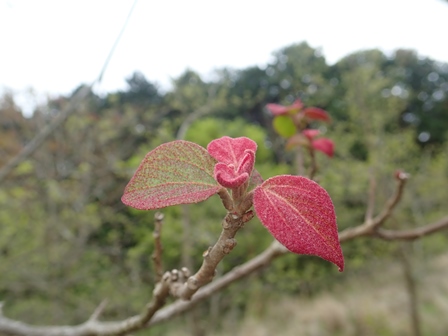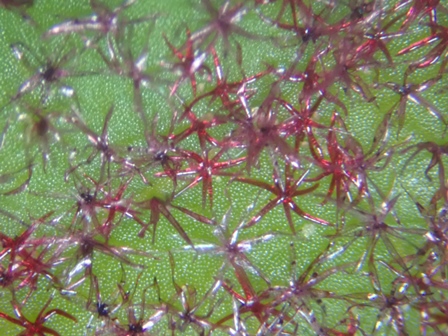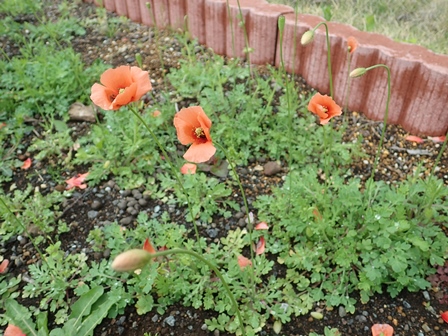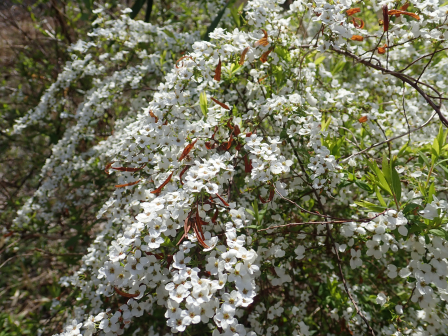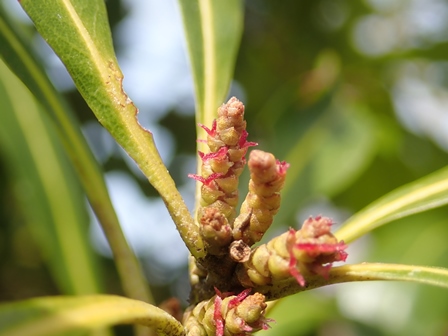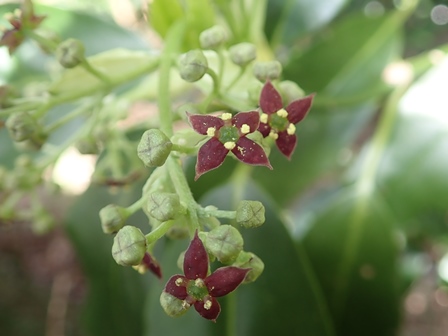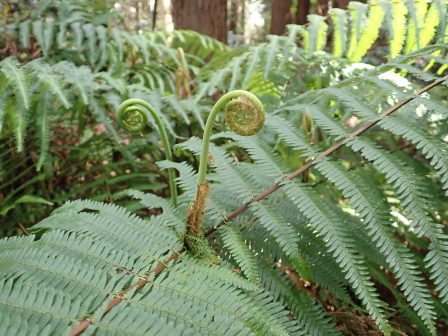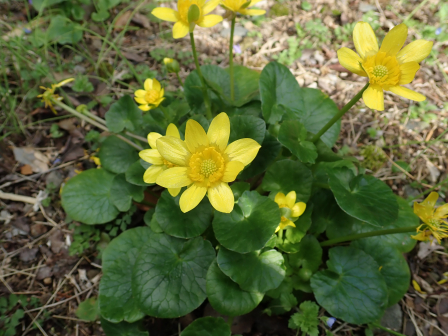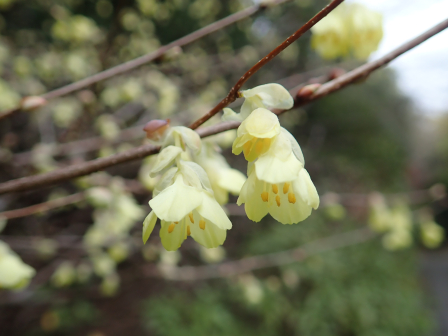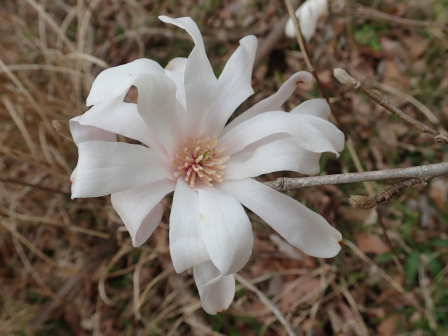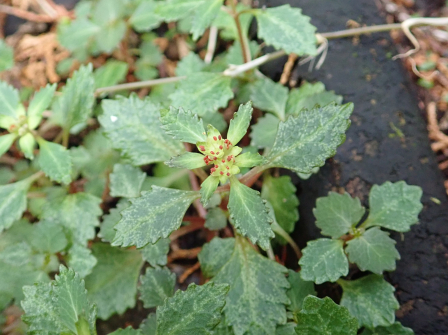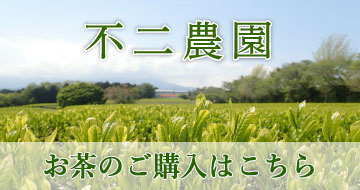フィールド日記
2022.04.22
アカメガシワ
共生の森でアカメガシワが新芽を出しています。伐採跡地などによく見られる落葉高木です。和名は、春にでる新芽が赤いことに由来します。
赤い葉を双眼実体顕微鏡で見ると、星状毛と呼ばれる形の赤い毛が密に生えていることがわかります。
"Akame-Gashiwa (アカメガシワ)" trees are sprouting new shoots in the Kyoseinomori(共生の森). They are a deciduous tall tree and often seen in logging sites. "Akame (アカメ)" in its name means "red sprout" and comes from the fact that their sprouts are red in spring. Seeing red leaves under a binocular stereo microscope, you can find red star-shaped hair growing densely.
2022.04.19
ナガミヒナゲシ
グラウンドの花壇にナガミヒナゲシが咲いています。道ばたや空き地などにふつうに見られるヨーロッパ原産の帰化植物で、近年著しく増えていると言われています。この花壇のものも植えてはいないので、どこからか種が入ってきたのだと思われます。
"Nagami-Hinageshi (ナガミヒナゲシ)" plants are in bloom in the flower bed in the school ground. They originally come from Europe and are often seen in roadsides and vacant lots. It is said that they are really increasing these days. We didn't plant them in this flower bed, so they should have come from somewhere.
2022.04.15
ユキヤナギ
共生の森でユキヤナギが咲いていました。名前にヤナギがつきますが、ヤナギのなかまではなく、バラ科です。自生地は川沿いの岩場などですが、広く栽培されており、各地に逸出しています。
"Yuki-Yanagi (ユキヤナギ)" trees are in bloom in the Kyoseinomori-Forest(共生の森). They have the word "Yanagi" in their name, but they belong to the rose family, not to the family of "Yanagi". They grow originally in rocky places along rivers, but they are cultivated in many places. Some of cultivated ones have spread and grow wild there.
2022.04.12
ヤマモモ
共生の森でヤマモモの花が咲いています。ヤマモモは雄花だけを咲かせる雄木と雌花だけを咲かせる雌木に分かれている雌雄異株です。共生の森に植栽されているヤマモモは雌木で、写真は雌花です。花はあまり目立ちませんが6月頃には1~2cmの赤い実がたくさんなります。
A "Yamamomo (ヤマモモ)" tree is in bloom in the Kyoseinomori-Forest(共生の森). They are dioecious, which have two distinct trees: ones that bloom only female flowers and the others that bloom only male flowers. The "Yamamomo" trees planted in the forest are female trees, so the photo shows their female flowers. The flowers do not stand out, but they will bear a lot of red fruit in Jun that is 1 to 2 cm in size.
2022.04.08
アオキ
聖心坂の近くの森でアオキが咲いていました。林内でよく見られる低木として、生物基礎の教科書でも紹介されています。和名は、常緑樹で、枝も緑であることに由来します。雌雄異株で、写真は雄花です。
An "Aoki (アオキ)" tree is in bloom in a forest near the "Seishin Zaka(聖心坂)". In a basic-biology textbook, they are known as a low tree often seen in forests. The name comes from the fact that they are an evergreen tree and their branches are also green. They are dioecious and the photo above shows the male flowers.
2022.04.05
ウラジロ
ヒノキ林の林床で、ウラジロの休止芽が伸びだしていました。ウラジロは地下茎から一対の羽片をもつ葉が伸びてきます。羽片の中央には芽がありますが、いったん成長を止めることから休止芽と呼ばれます。休止芽は翌年の春に伸びて、新たな一対の羽片と休止芽をつけます。このように毎年1段ずつ成長していくので、2m以上になるものもあります。ウラジロは縁起がよい植物としてお正月の飾りに使われます。
A resting bud of "Urajiro (ウラジロ)" fern plants is starting to grow on the Japanese cypress woodland floor. They grow from an underground stem with a pair of pinnate leaves. There is a bud at the center of the pair of pinnate leaves, but the bud stop growing once. this is why the bud is called "resting bud". The resting bud starts to grow in the next spring and produce a new pair of pinnate leaves and a new resting bud again. As they grow step by step every year, their leaves can grow up to more than 2 meter in length. They are regarded as lucky plants, so they are used for the ornaments for the New Year's Day.
2022.04.01
ヒメリュウキンカ
正門の近くでヒメリュウキンカが咲いています。ヨーロッパ原産で、各地で栽培されているものが逸出し、野生化しています。花弁には独特な光沢があります。
"Hime-Ryuukinka (ヒメリュウキンカ)" plants are in bloom near the main gate. They originally come from Europe and are cultivated in many places. Some of the cultivated ones have spread and now grow wild. Their petals have unique luster.
2022.03.29
ヒュウガミズキ
裏道でヒュウガミズキが咲いていました。近畿地方の日本海側など限られた地域にしか自生していませんが、各地で植栽されています。和名のヒュウガとは現在の宮崎県を指すと思われますが、最近まで宮崎県に自生するとは考えられていなかったため、由来はよくわかっていないようです。
A "Hyuuga-Mizuki (ヒュウガミズキ)" tree is in bloom on the back road. They, as wild plants, grow in limited areas such as the Japan Sea side of the Kinki region, but people in other places also plant the trees. "Hyuuga (ヒュウガ)" in its name could mean current Miyagi prefecture, but it's not clear where the name originally comes from, because it was found only recently that the trees grow in Miyagi prefecture.
2022.03.25
シデコブシ
共生の森に植栽されたシデコブシが咲いています。コブシに似ていますが、花びらがコブシよりもたくさんあるのが特徴です。野生として東海地方の一部のみに自生し、絶滅が危惧されていますが、庭木として各地に植栽されています。
The "Shide-Kobushi (シデコブシ)" tree planted in the Kyoseinomori-Forest(共生の森) is in bloom. They are similar to "Kobushi (コブシ)" trees, but they have more petals. "Shide-Kobushi" trees, as wild plants, grow in only a part of Tokai area and are considered an endangered species, but people in many places usually plant the trees in gardens.
2022.03.22
ニッコウネコノメ
裏道でニッコウネコノメが咲いていました。ネコノメソウの仲間は似ているものも多く、見分けるのが難しいものもあります。ニッコウネコノメはイワボタン(別名ミヤマネコノメ)の変種で、開花直後の葯が赤褐色であることと、がく片が斜開から平開することが特徴です。
"Nikkou-Nekonome (ニッコウネコノメ)" plants are in bloom on the back road. Plants belonging to "Nekonome-Sou (ネコノメソウ)" resemble each other, so sometimes it's difficult to tell one from the others. "Nikkou-Nekonome" plants are a variety of "Iwabotan (イワボタン)" plants. They are characterized by their dark red anthers immediately after flowering and their half-open or open sepals.


